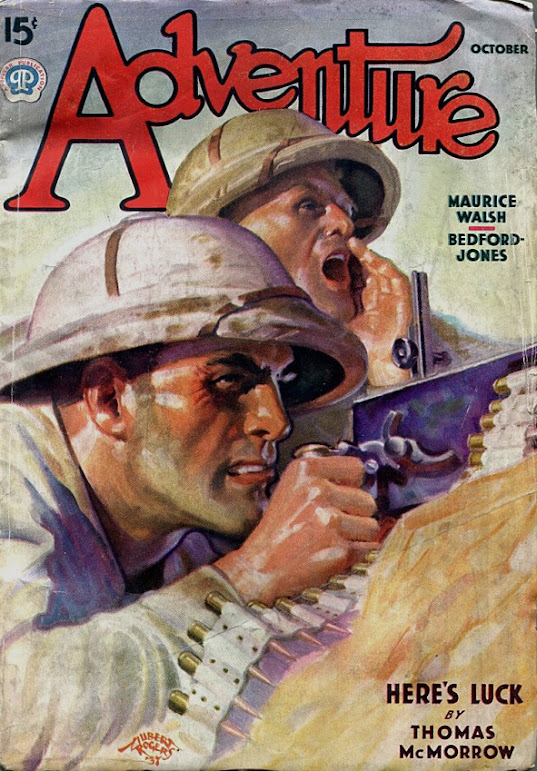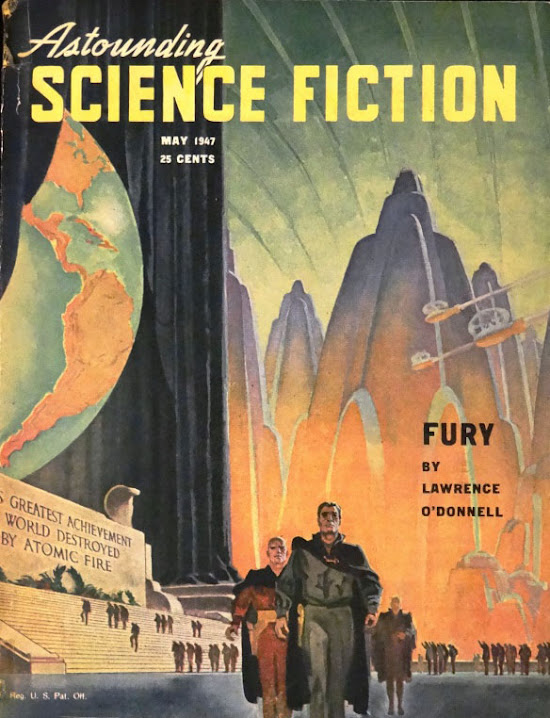Pulp magazines were inexpensive fiction magazines that were published from around 1896 to the 1950s. The term “pulp” derives from the cheap wood pulp on which the magazines were printed. In contrast, magazines printed on higher-quality paper were called "glossies" or "slicks".
The pulps gave rise to the term pulp fiction in reference to run-of-the-mill, low-quality literature. Pulps were the successors to the penny dreadfuls, dime novels, and short fiction magazines of the 1800s. Although many respected writers wrote for pulps, the magazines were best known for their lurid, exploitative, and sensational subject matter. Modern superhero comic books are sometimes considered descendants of "hero pulps"- pulp magazines often featured illustrated novel-length stories of heroic characters, such as Flash Gordon, The Shadow, Doc Savage, and the Phantom Detective.
At their peak of popularity in the 1920s and 1930s, the most successful pulps could sell up to one million copies per issue. The most successful pulp magazines were Argosy, Adventure, Blue Book, and Short Stories, collectively described by some pulp historians as "The Big Four.” Among the best known other titles of this period were Amazing Stories, Black Mask, and Dime Detective, among others.
1939 Robert de Graff launched Pocket Books. It was the first American mass-market-paperback line, and it transformed the industry. But paper book covers are almost as old as print. They date back to the sixteenth century, and paper-backing has been the ordinary mode of book production in France, for a long time. The first edition of James Joyce’s “Ulysses,” published in Paris in 1922, is a paperback. In the United States, paperback publishing was tried on a major scale at least twice during the nineteenth century: first, in the eighteen-forties, with an enterprise called the American Library of Useful Knowledge, and after the Civil War, when, unfettered by international copyright agreements, American publishers brought out cheap editions of popular European novels.
Many notable authors and books were first published as pulp fiction:
Tarzan of the Apes first appeared serialised in 1912-13 editions of All-Story magazine. Dashiell Hammet’s The Maltese Falcon was originally published in Black Mask magazine in 1930, and The Thin Man in 1934 in Redbook.
This is part 4 of a 4-part series on Pulp Fiction featuring the 1910s - 1920s.
Later larger series will feature Pulp Fiction of the 1930s, and Pulp Fiction of the 1940s - 1950s.
 |
| Hubert Rogers |
Hubert Rogers was born in 1898. Best known as Astounding Science Fiction’s primary cover artist from 1939 to 1953, his illustrations also graced the covers and interiors of Adventure, Argosy, Short Stories, Detective Story, The Whisperer, The Wizard, Ace-High, West, Romance, Love Story, and Sport Story. Rogers trained at the Acadia Art Academy in Nova Scotia. As an art student of exceptional promise, he was introduced to the prestigious Group of Seven with A.Y. Jackson, becoming his lifelong friend and mentor. After enlisting in the Canadian Army to fight in the First World War, Rogers settled in the United States where he continued his art studies in Boston and New York
Having opened his own art studio in Brooklyn Heights, Rogers had a daughter and ex-wife to support while continuing his studies. He supplemented his income with newspaper work and by freelancing for pulp magazines. Rogers’ association with the pulps would limit his ability to find work with some of the higher-paying slicks and publishing houses.
During the Great Depression, Rogers relocated to New Mexico where he lived and worked among a thriving community of artists and bohemians for five years. The growing volume of pulp assignments brought him back to New York in 1936 where he settled in Greenwich Village and met and married his second wife. Moving back to Canada in 1942, Rogers was employed by the Wartime Information Board in Ottawa where he produced numerous wartime Adventure magazine propaganda posters.
After the Second World War, Rogers moved his wife and their young son to Vermont where his second daughter would be born in 1947. Rogers stayed busy with pulp assignments through the early 1950s. Later in life, Rogers painted landscapes and commissioned portraits of U.S. and Canadian politicians and other prominent citizens. He died in Ottawa in 1982 at age 83.
 |
| 1929 Adventure February 1 issue Catspaw of Piperock by W.C. Tuttle |
 |
| 1929 Adventure May 15 issue North of Singapore by H. Bedford-Jones |
 |
| 1932 Adventure October 1 issue Three complete Novelettes |
 |
| 1934 Adventure January issue Distinctive Stories by... |
 |
| 1935 Adventure August 1 issue Killers Cold by Arthur O. Friel |
 |
| 1935 Adventure May 15 issue Damned Dutchman by Gordon Young original cover artwork oil painting |
 |
| 1935 Adventure May 15 issue Damned Dutchman by Gordon Young |
 |
| 1935 Adventure September 1 issue Two Novelettes |
 |
| 1935 Dime Adventure June issue Tropic Treasure by H. Benge Six Cases of Rifles by William Chamberlain |
 |
| 1936 Argosy August 22 issue Don Peon by Johnston McCulley |
 |
| 1936 Argosy September 19 issue Tarzan and the Magic Men by Edgar Rice Burroughs |
 |
| 1937 Adventure October issue Here's Luck by Thomas McMorrow |
 |
| 1938 Adventure January issue original cover artwork oil painting |
 |
| 1938 Adventure March issue Six Feet and Horse-Faced by Caddo Cameron |
 |
| 1939 Astounding Science Fiction February issue Crucible of Power by Jack Williamson |
 |
| 1939 Astounding Science Fiction October issue "Skylark" Smith |
 |
| 1939 Detective Story March issue Lester Leith and The Fourth Musketeer by Erle Stanley Gardner |
 |
| 1939 Detective Story March issue original cover artwork oil painting |
 |
| 1940 Astounding Science Fiction February issue "If This Goes On..." by Robert Heinlein |
 |
| 1940 Astounding Science Fiction August issue The Stars Look Down by Lester Del Rey |
 |
| 1940 Astounding Science Fiction December issue Old Man Mulligan by P. Schuyler Miller |
 |
| 1940 Astounding Science Fiction July issue Crisis in Utopia by Norman L. Knight |
 |
| 1940 Astounding Science Fiction November issue "Salvage" by Vic Phillips |
 |
| 1940 Astounding Science Fiction October issue "Slan!" by A.E. Van Vogt |
 |
| 1940 Astounding Science-Fiction June issue The Roads Must Roll by Robert Heinlein original cover artwork |
 |
| 1940 Astounding Science-Fiction June issue The Roads Must Roll by Robert Heinlein |
 |
| 1941 Adventure December issue cover Viva China! by James Norman |
 |
| 1941 Astounding Science Fiction November issue Second Stage Lensman bt E.E. Smith, Ph.D. |
 |
| 1941 Astounding Science Fiction April issue The Stolen Dormouse by L. Sprague de Camp original artwork acrylic paint |
 |
| 1941 Astounding Science Fiction April issue The Stolen Dormouse by L. Sprague de Camp |
 |
| 1941 Astounding Science Fiction August issue Jurisdiction by Nat Schachner |
 |
| 1941 Astounding Science Fiction February issue Magic City by Nelson S. Bond |
 |
| 1941 Astounding Science Fiction January issue "Sixth Column" by Anson MacDonald |
 |
| 1941 Astounding Science Fiction July issue Methuselah's Children by Robert Heinlein |
 |
| 1941 Astounding Science Fiction June issue Time Wants a Skeleton by Ross Rocklynne |
 |
| 1941 Astounding Science Fiction March issue Logic of Empire by Robert Heinlein |
 |
| 1941 Astounding Science Fiction May issue Universe by Robert Heinlein |
 |
| 1942 Astounding Science Fiction August issue Waldo by Anson MacDonald |
 |
| 1942 Astounding Science Fiction January issue original artwork oil paint |
 |
| 1942 Astounding Science Fiction June issue Bridle and Saddle by Isaac Asimov |
 |
| 1942 Super Science Fiction August issue original artwork |
 |
| 1942 Super Science August issue |
 |
| 1947 Astounding Science Fiction March issue The Equalizer by Jack Williamson |
 |
| 1947 Astounding Science Fiction May issue Fury by Lawrence O'Donnell |
 |
| 1948 Astounding Science Fiction January issue Now You See It by Isaac Asimov |
 |
| 1948 Astounding Science Fiction March issue ... And Searching Mind by Jack Willianson |
 |
| 1949 Astounding Science Fiction November issue ... And Now You Don't by Isaac Asimov |
 |
| 1949 Astounding Science Fiction February issue Seetee Shock by Will Stewart |
 |
| 1950 Astounding Science-Fiction April issue The Wizard of Linn by A.E. van Vogt |
 |
| 1950 Astounding Science Fiction December issue Bindlesstiff by James Blish |
 |
| 1950 Astounding Science Fiction February issue To the Stars by L. Ron Hubbard |
 |
| 1950 Astounding Science Fiction September issue The Lion and the Lamb by Fritz Leiber |
 |
| 1951 Astounding Science Fiction June issue ... And Then There Were None by Eric Frank Russell |
 |
| 1951 Astounding Science Fiction December issue Outward Bound |
 |
| 1951 Astounding Science Fiction July issue The End of the Line by James Schmitz |
 |
| 1951 Astounding Science Fiction September issue Day of the Moron by H. Beam Piper |
 |
| 1952 Astounding Science Fiction January issue That Share of Glory by C.M. Kornbluth |
 |
| 1952 Astounding Science-Fiction April issue Dumb Waiter by Walter M. Miller, Jr |
 |
| Date? Dime Adventure Magazine June issue Tropic Treasure by H. Benge |
No comments:
Post a Comment
Note: only a member of this blog may post a comment.